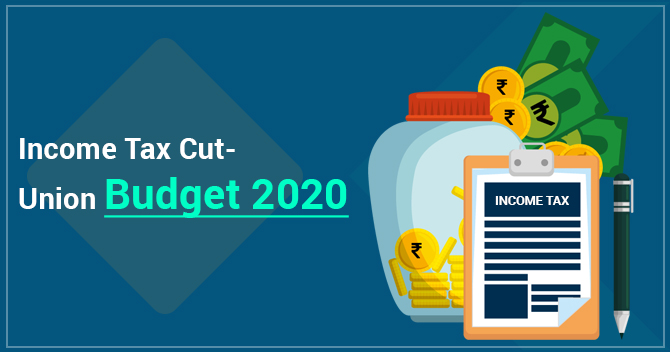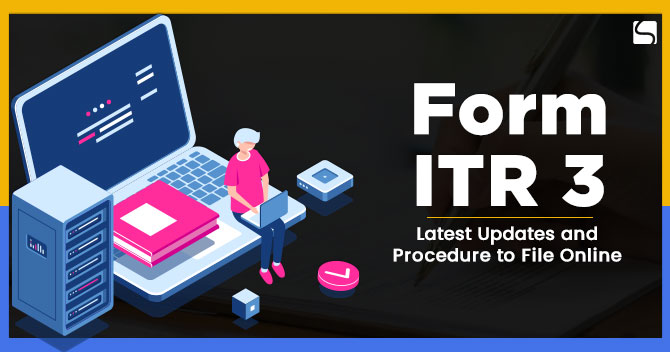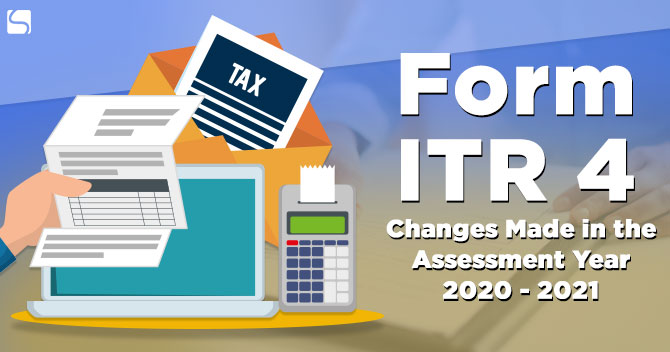Form ITR 6: Concept and Amendments Made for the F.Y. 2019-20
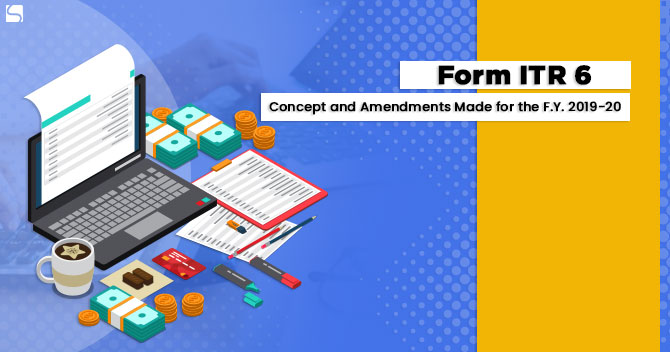
Shivani Jain | Updated: Sep 16, 2020 | Category: Income Tax
The term “Form ITR 6” denotes an Income Tax Return filed by the companies that are not claiming exemption under section 11 of the Income Tax Act 1961. Further, section 11 of the act deals with the Income from Property held for a Religious and Charitable purpose.
In this blog, we will discuss the concept of Form ITR 6, together with the amendments made and its procedure for filing online.
Table of Contents
Meaning of Income Tax Return
The term “Income Tax Return” or “ITR” denotes an e-form that is used by the taxpayer or assessee to file details and information about his/her earned income to the Income Tax Department. Further, the tax liability of an assessee is determined on the basis of the income earned by him/her.
Moreover, all the Individuals (including Businesses) must submit details regarding the income earned during a Financial Year.
Also, the process of submitting an ITR to the Income Tax Department is known as Income Tax Return Filing.
Brief Summary of the Form ITR 1 to 5 and 7
The brief summary of the Form ITR 1 to 5 and 7 are as follows:
Form ITR 1
The term “Form ITR 1” signifies an Income Tax Return filed by the individuals who are RNOR (Resident other than Not Ordinarily Resident) and having Annual Income up to Rs. 50 lakhs.
Form ITR 2
The term “Form ITR 2” signifies an Income Tax Return (ITR) filed by the individuals or Hindu Undivided Family (HUFs) who are not generating income from the PGBP (Profit and Gain from Business or Profession). Further, it does not apply to the individuals who are submitting Form ITR 1 (Sahaj).
Form ITR 3
The term “Form ITR 3” signifies an Income Tax Return (ITR) filed by the Individuals or Hindu Undivided Family (HUFs) who are generating income from the PGBP (Profit and Gain from Business or Profession). However, it shall be relevant to note that it does not apply to the individuals who are filing Form ITR 2.
Form ITR 4
The term “Form ITR 4” signifies an Income Tax Return (ITR), which is filed by the taxpayers or assessee who are falling under the category of “Presumptive Income Scheme”, specified under section 44 AD, section 44 ADA, and section 44 E of the IT Act 1961. Further, the other name for the Income Tax Return 4 is “Sugam”.
Form ITR 5
The term “Form ITR 5” signifies an Income Tax Return (ITR) filed by every taxpayer or assessee who is neither filing Form ITR 7 nor submitting any return under section 139(4A), 139(4B), or 139(4D). Moreover, this ITR includes all the Heads of Income except the income mentioned under section 11 of the Income Tax Act 1961.
Form ITR 7
The term “Form ITR 7” signifies a tax return that is filed by individuals who act as a Trust, Firm, Company, Local Authority, AOP (Association of Persons) and claims deductions under section 139(4A), section 139 (4B), section 139 (4C), and 139 (4D).
Who are all Eligible to File Form ITR 6?
All the Companies that are not claiming exemption under section 11 of the Income Tax Act needs to file Form ITR 6 with the Income Tax Department.
Who are all not Eligible to File Form ITR 6?
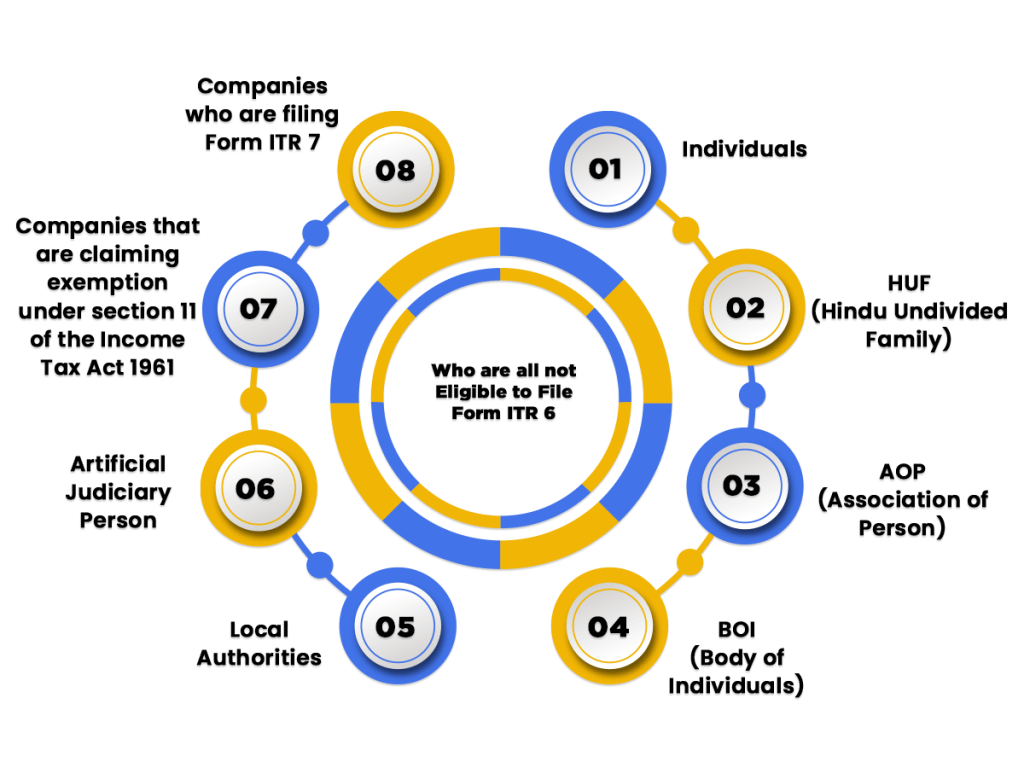
The ones who are not eligible to file Form ITR 6 are as follows:
- Individuals;
- HUF (Hindu Undivided Family);
- AOP (Association of Person);
- BOI (Body of Individuals);
- Local Authorities;
- Artificial Judiciary Person;
- Companies that are claiming exemption under section 11 of the Income Tax Act 1961;
- Companies who are filing Form ITR 7;
Due Dates for Filing Form ITR 6
The due dates for filing ITR Form 6 has been extended by the Central Government and Income Tax Department till 30.11.2020.
Amendments Made in ITR Form 6
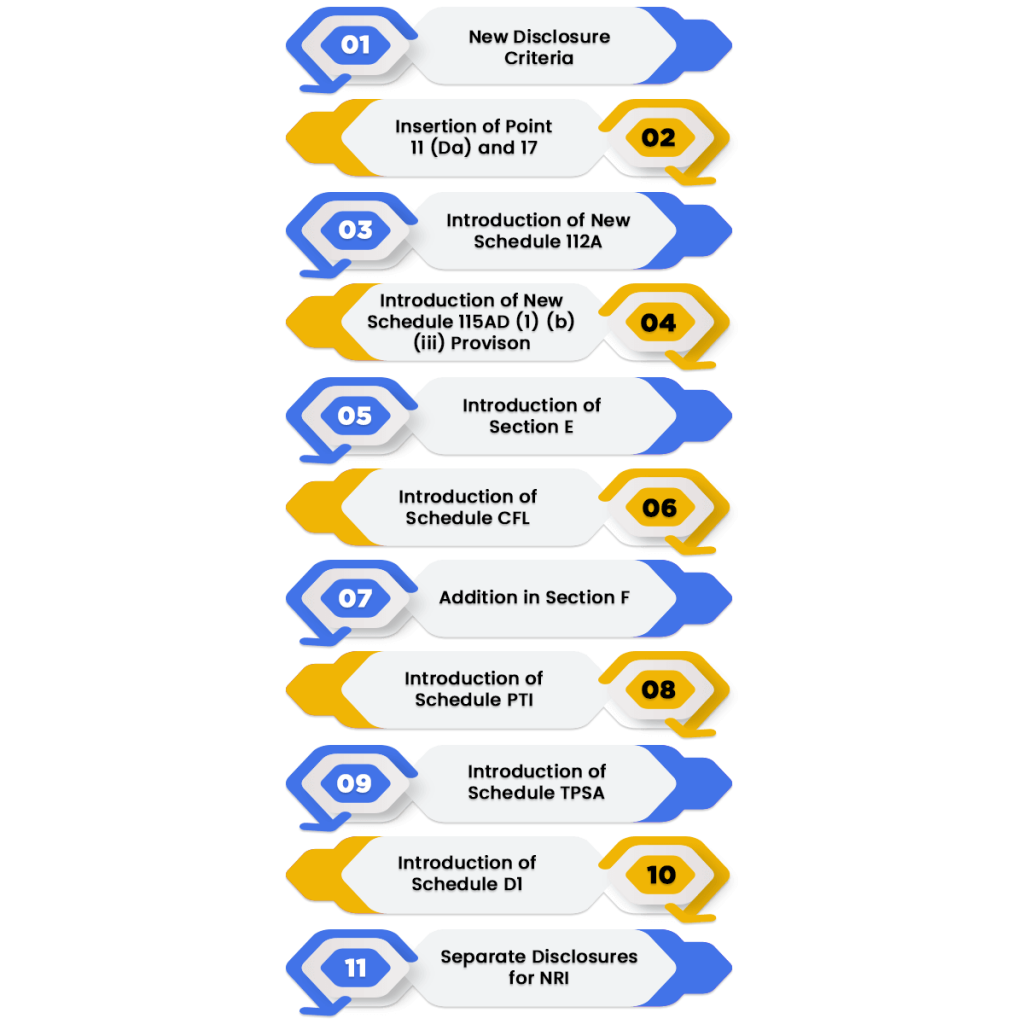
The amendments made in Form ITR 6 are as follows:
New Disclosure Criteria
Now, the IT Department has introduced “new disclosure criteria” for declaring income earned under the “Presumptive Income Scheme”, such as section 44 AE, 44 B, 44 BB, 44 AD, 44 ADA, 44 BBA, 44 BBB.

Insertion of Point 11 (Da) and 17
For the Assessment Year 2020 – 2021, the Income Tax Department, together with the Central Government have introduced 2 “new points of Disclosure” under the head Other Information, named Point 11(Da) and Point 17.
Point 11
Any amount debited to the profit & loss account for the previous financial year but disallowable under section 43B.
Sub Point DA
Any amount payable by the taxpayer or assessee as interest on any borrowing or loan is taken either from a deposit-taking NBFC or a systemically important non deposit taking NBFC, in accordance with the terms and conditions provided under the agreement governing such loan or borrowing.
Point 17
Under this head of income, the assessee needs to “mark the option” whether he/she is using the option provided under subsection 2A of section 92 CE or not.


Introduction of New Schedule 112A
All the details regarding the Equity Oriented Fund, Equity Shares, or Unit of a Business Trust on which STT (Securities Transaction Tax) is paid under section 112 A.

Introduction of New Schedule 115AD (1) (b) (iii) Proviso
This newly introduced schedule specifically deals with the NRIs (Non Residents Indians), who have been engaged in the “Sale of Shares”, “Unit of Equity-oriented Fund”, or “Unit of a Business” on which STT (Securities Transaction Tax) has been duly paid under section 112A.

Introduction of Section E
The Central Government and the Income Tax Department have introduced a “new section” named “Computation of Income from Life Insurance Business” specified in “Section 115 B”. This section has been introduced under the “Head of Income from Business or Profession”.

Introduction of Schedule CFL
The term “CFL” is the abbreviated form for the “Carry Forward Losses”. According to this schedule, a taxpayer or assessee requires to provide “details and information” regarding the Losses Incurred in a financial year in two columns, named as follows:
- Normal Loss;
- PTI

Addition in Section F
For the Computation of the Income from the Business or Profession, in section “F – Intra Head Set-off of the Business Loss of the Current Year”, the following point has been added:
- Income from the Life Insurance business under section 115B;

Introduction of Schedule PTI
This newly introduced schedule will include the details and information as follows:
- Investments made under section 115 UA and 115 UB;
- Classification of Income as follows:
- Current Year Income;
- Share and Portion in the Current Year Loss distributed by the Investment Fund; and
- Net Income or Loss;


Introduction of Schedule TPSA
All the details and information regarding the “Tax on Secondary Adjustments”, according to section 92 CE (2A), are covered under this schedule.

Introduction of Schedule D1
Under this newly introduced schedule of the form, theassessee or taxpayer requires to furnish all the details and information regarding donations, deposits, and investments made by him/ her up to 31.07.2020.
Further, these investments are qualified to be claimed as deduction under chapter VI-A of the Income Tax Act 1961 for the Financial Year 2019 – 2020.

Separate Disclosures for NRI
According to the new ITR form, the applicant or taxpayer who is an NRI (Non Resident Indian) and is not having any Bank Account in India, but desires to claim a Refund of Income Tax, requires to provide the details and information as follows:
- Name of the Bank;
- Name of the Country;
- SWIFT Code;
- IBAN (International Bank Account Number);

Structure of Form ITR 6
The Structure of ITR Form 6 can be summarised as:
- Part A: General information;
- Part A- BS: Balance Sheet as on 31.03.2019;
- Part A- BS-Ind AS: Balance Sheet as on 31.03.2020, or as on the date of the business combination;
- Part A- Manufacturing Account: for the F.Y. 2019 – 2020;
- Part A- Trading Account: for the F.Y. 2019 – 2020;
- Part A- P&L: Profit & Loss Account: for the F.Y. 2019 – 2020;
- Part A- Manufacturing Account- Ind AS: Manufacturing Account for the F.Y. 2019 – 2020;
- Part A- Trading Account Ind- AS: Trading Account for the F.Y. 2019 – 2020;
- Part A- P&L Ind-AS: Profit & Loss Account for the F.Y. 2019 – 2020;
- Part A- OI: Other Information;
- Part A- QD: Quantitative Details;
- Part A- OL: Receipt and Payment Account of the company under liquidation;
- Part B- TI: Computation of Total Income;
- Part B- TTI: Computation of the Tax Liability on Total Income;
- Tax payments:
- Details of payments of the Advance Tax and Self-Assessment Tax;
- Details of the Tax Deducted at Source (TDS) on the Income (according to Form 16A/ 16B/ 16C);
- Details of the Tax Collected at Source (TCS);
- Schedule- HP: Computation of the Income under the head of Income from House Property;
- Schedule- BP: Computation of the Income under the head of Profit and Gains from the Business or Profession;
- Schedule- DPM: Computation of the Depreciation on the Plant and Machinery under the Income Tax Act, 1961;
- Schedule DOA: Computation of the Depreciation on other assets under the Income Tax Act, 1961;
- Schedule DEP: Summary of the Depreciation charged on all the assets prescribed under the Income Tax Act, 1961;
- Schedule DCG: Computation of the Deemed Capital Gains on the sale of the Depreciable Assets;
- Schedule ESR: Deduction under section 35 of the Income Tax Act (expenditure on scientific research);
- Schedule CG: Computation of the Income under the head of Capital Gains;
- Schedule OS: Computation of the Income under the head of Income from Other Sources;
- Schedule CYLA: Statement of the Income after setting off the current year losses;
- Schedule BFLA: Statement of the income after setting off of the unabsorbed loss brought forward from the previous years;
- Schedule CFL: Statement regarding the losses to be carried forward to the future years;
- Schedule UD: Details of the unabsorbed depreciation and the allowance under section 35 (4) of the Income Tax Act;
- Schedule ICDS: Effect of the “Income Computation Disclosure Standards” on the profit generated;
- Schedule 10 AA: Computation of the deduction allowed under section 10AA;
- Schedule 80 G: Details regarding the donation entitled as a deduction under section 80 G of the Income Tax Act, 1961;
- Schedule 80 GGA: Details regarding the donations made for the scientific research or some rural development;
- Schedule RA: Details regarding the donations made to the research associations etc.;
- Schedule 80 IA: Computation of the deduction allowed under section 80 IA;
- Schedule 80 IB: Computation of the deduction allowed under section 80 IB;
- Schedule 80 IC or 80 IE: Computation of the deduction allowed under section 80 IC or 80 IE;
- Schedule VI A: Statement regarding the deductions allowed (from total income) under Chapter VI A of the Income Tax Act, 1961;
- Schedule SI: Statement regarding the income earned which is chargeable to tax at a special rate;
- Schedule PTI: Pass through Income details from the business trust or investment fund;
- Schedule EI: Statement regarding the Income not included in the total income, i.e., exempt incomes;
- Schedule MAT: Computation of the Minimum Alternate Tax (MAT) payable under section 115 JB of the Income Tax Act, 1961;
- Schedule MATC: Computation of the Tax credited under section 115 JAA;
- Schedule DDT: Details regarding the payment of DDT (Dividend Distribution Tax);
- Schedule BBS: Details of the tax charged on distributed income of a domestic company on the buyback of shares, not listed on the recognised stock exchange;
- Schedule TPSA: Secondary adjustment to TP (Transfer Price) as per section 92 CE (2A);
- Schedule FSI: Details of the Income earned from anywhere outside India and Tax Relief;
- Schedule TR: Summary of the tax relief claimed for the taxes paid outside India;
- Schedule FA: Details of the Foreign Assets and income earned from any source outside India;
- Schedule SH 1: Details regarding the Shareholding of an unlisted company;
- Schedule SH 2: Details regarding the Shareholding of Start-ups;
- Schedule AL 1: Details regarding the Assets and Liabilities as at the end of the financial year;
- Schedule AL 2: Details regarding the Assets and Liabilities as at the end of the Financial Year (applicable to start-ups only);
- Schedule DI: Schedule of the Tax Saving Investments or deposits or payments to claim exemption or deduction in the extended period from 01.04.2020 until 30.06.2020;
- Schedule GST: Information concerning the annual turnover or gross receipt reported for GST;
- Schedule FD: Break-up of the payments/ receipts in the Foreign currency;
Process to Download Form ITR 6
One can download Form ITR 6 from the official website of the Income Tax Department, as there are no offline tools provided by the IT Department to file Form ITR 6.
Procedure to file Form ITR 6
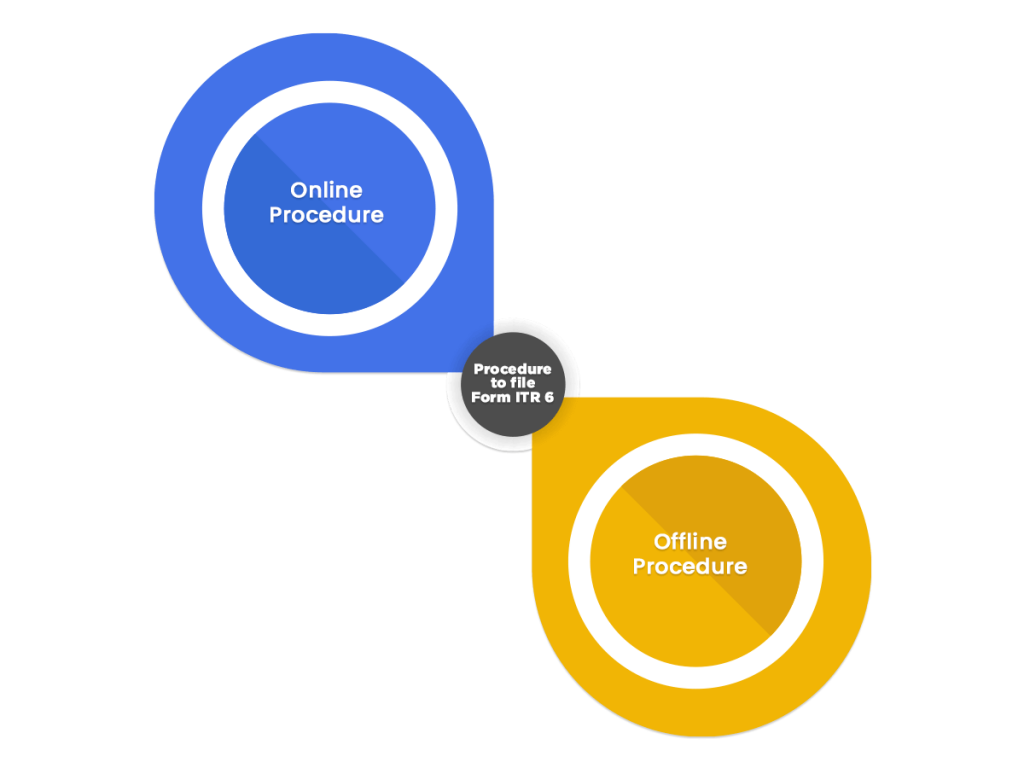
There are 2 different modes of filing Form ITR 6, which are as follows:
- Online Procedure;
- Offline Procedure;
Offline Process to File Form ITR 6
The offline modes for Filing ITR 6 are as follows:
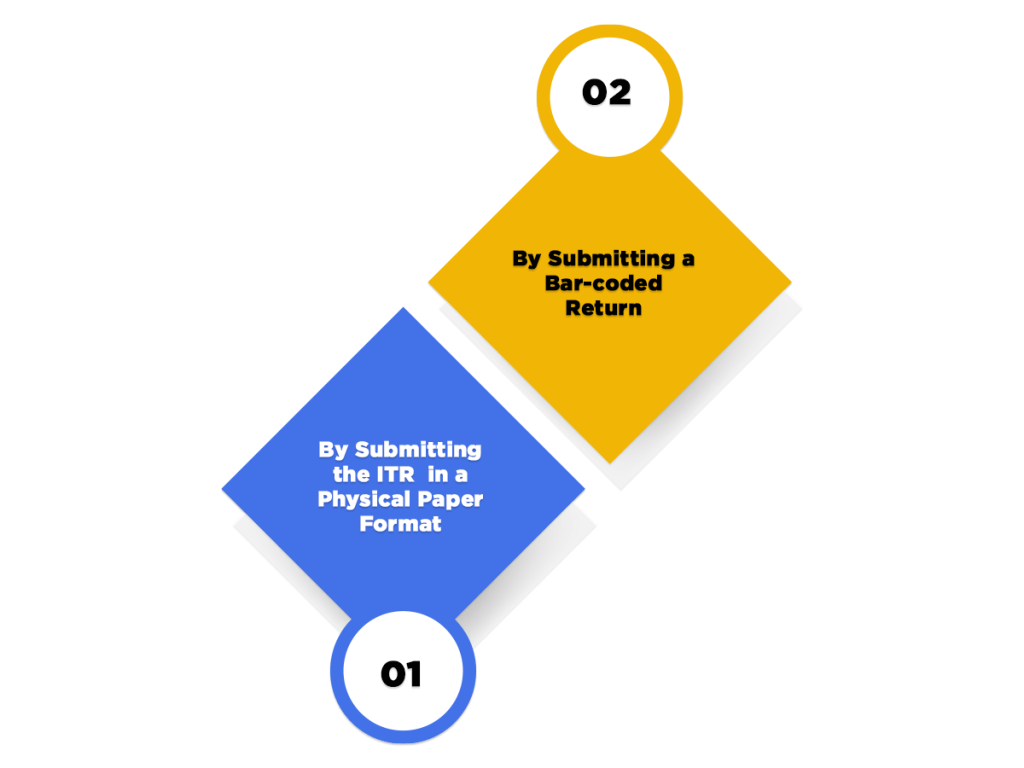
- By Submitting the Income Tax Return in a Physical Paper Format;
- By Submitting a Bar coded Return;
Online Procedure to File Form ITR 6
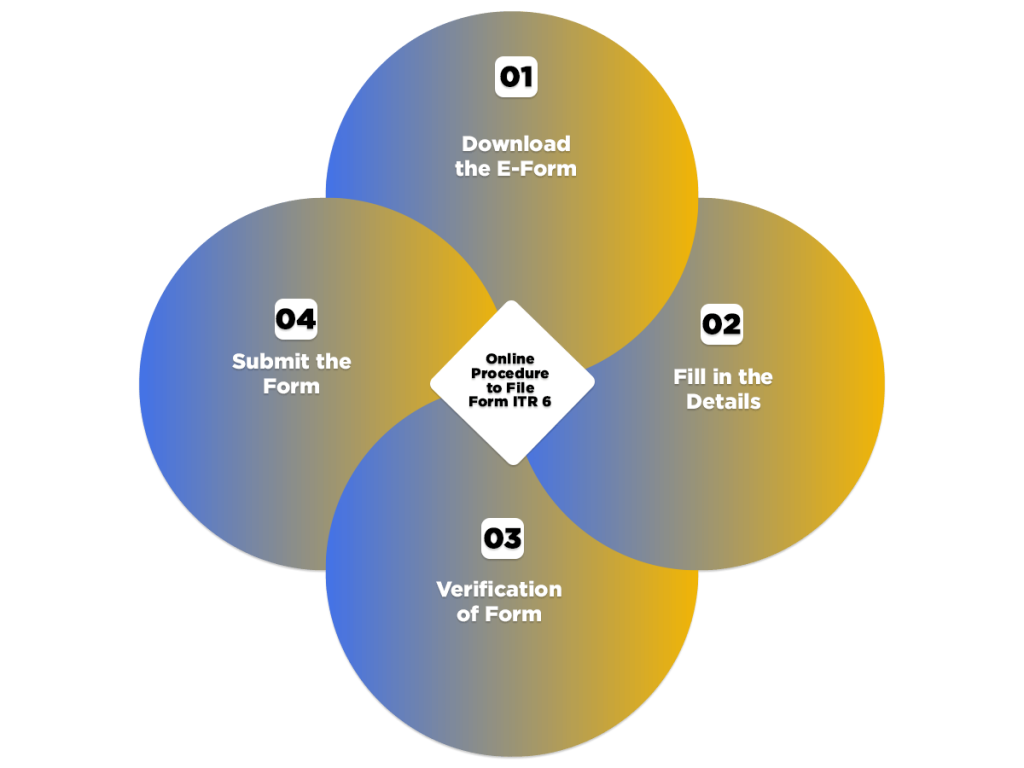
The steps involved in the procedure to file Form ITR 6 online are as follows:
Download the E-Form
Firstly, the taxpayer or applicant requires to download the Form ITR 6 from the official Income Tax Website at http://www.incometaxindiaefiling.gov.in/home;
Fill in the Details
In the next step, the taxpayer requires to enter all the details and information asked in different parts of the e-form.
Verification of Form
Now, the applicant requires to get his/ her Form ITR 6 verified or authenticated in the modes prescribed as follows:
- By Getting the Form ITR 6 signed Digitally;
- By Validating the Form ITR 6 through EVC (Electronic Verification Code);
Submit the Form
Lastly, the concerned taxpayer or applicant who wants to submit his/ her ITR form online will receive a mail of acknowledgment on his/ her registered email id.
However, if in case the taxpayer desires to send the ITR manually or physically by downloading it from the official IT website, he/she needs to courier the same to the CPC Office of Income Tax Department, situated at Bangalore, within a period of 120 days, starting from the date of filing of Form ITR 6.
Moreover, it shall be noteworthy to state that Form ITR 6 is an annexure less form, which means there is no need for the applicant to attach any record or document.
Conclusion
In a nutshell, all the Companies that are not claiming exemption under section 11 of the Income Tax Act needs to file Form ITR 6 with the Income Tax Department. Further, the due dates for filing ITR Form 6 has been extended by the Income Tax Department and Central Government till 30.11.2020.
Performa for ITR Form 6 of the A.Y. 2020- 2021
itr6_englishAlso, Read:Transparent Taxation: PM Decides to Honor Honest Taxpayer












